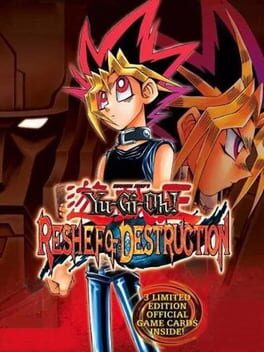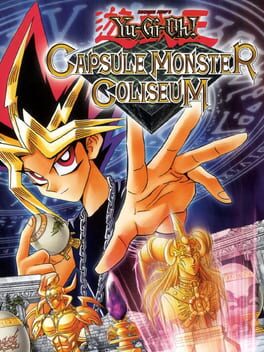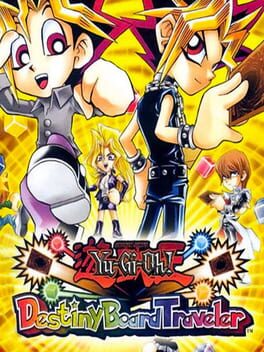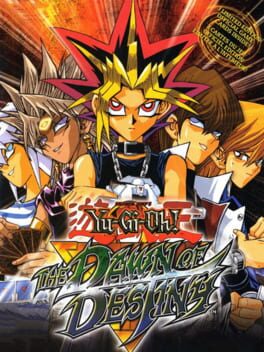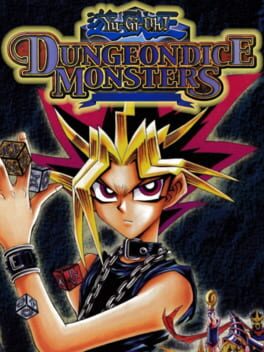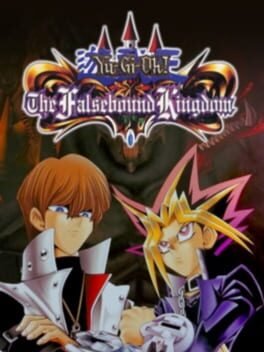

In your return to Battle City, you begin another mission to retrieve stolen millennium cards that can destroy the world. Yu-Gi-Oh! Reshef of Destruction features an all-new storyline that sets you off on a quest to stop Reshef from drowning the world in darkness. Since the game's battles are fought with cards, you must build a strong deck from 800 different cards (including all three Egyptian god cards) to even stand a chance against your enemies.
Also in series
Released on
Genres
Reviews View More
This game is as much a love letter to Yu-Gi-Oh! Duel Monsters as it is a punch to the balls.
Also the strongest 6/10 I've ever played, I love this game but it won't love you back.
ABOUT RESHEF
In the realm of Yu-Gi-Oh! games, Reshef stands tall in its unique traits. It is the eighth Duel Monsters title,or ninth if you count Forbidden Memories, and retains the style of gameplay found in all titles except for DM5 (Eternal Duelist's Soul) and DM6 (Worldwide Edition: Stairway to the Destined Duel), this playstyle being a sort of pseudo-Yugioh that was developed before the Official and Expert rules of the card game.
This review is written mostly for those who already know the rules of the trading card game (which this game differs very much from). If you're reading this and don't know them, I'll include a quick glossary of the mechanics. Feel free to skip this section.
GLOSSARY
- DECK: In this game, comprised of 40 cards.
- MONSTERS: Mainly yellow or orange. Can be normal summoned (played face up) or set (played horizontally, face down). They have Alignment, Type, Attack, Defense, Level and can have an Effect. Main means of dealing damage to the opponent's LP.
- NORMAL SUMMON/SET: of a monster. A duelist can only do this once per turn.
- SPECIAL SUMMON: In this game, some cards' effects allow the duelist to special summon a monster from outside their deck. A special summon can happen as many times as you want, only limited by the effects that conduct it.
- EFFECT MONSTERS: Orange monsters. In this game, there are two types of effects: an effect that the duelist can activate, which will reveal the monster and mark it as having acted in the turn (meaning it can't attack); and a continuous effect that will notify both duelists when the turn begins, when placing cards, when changing positions, activating spells, etc (yes it's a fucking headache but those are some of the best monsters).
- TRIBUTE SUMMON: If a monster is of high level, it will need a tribute for its normal summon. If a monster is level 1-4, it doesn't need a tribute. A monster leveled 5-6 needs one tributed monster in order to be normal summoned, and a monster leveld 7 or above needs two tributed monsters. Certain cards can require 3 tributes.
- SPELL CARDS: Green. Have a wide range of effects, from healing LP, destroying monsters/spells/traps, creating a field that powers up monsters of the corresponding type. Can be used anytime during your turn.
- TRAP CARDS: Purple. You can set as many as you like during your turn. In this game, they only activate when conditions are met, including monster attacks, monsters with certain attack numbers' attacks, powering up monsters, etc. Their effects tend to be disruptive, such as destroying monsters, stopping attacks, turning power ups into power downs, etc.
- BACKROW: Used to refer mostly to spells and/or traps that a duelist has set on the field.
Now, let's begin by discussing mainly the game's mechanics.
THE ALIGNMENT SYSTEM
- What is it?
Since DM2, the games have implemented two alignment circles, with the monster that has the weaker alignment being automatically destroyed at the beginning of battle (if it has higher ATK/DEF) or after the damage is dealt (if it has lower ATK).
This changes a decent bit about "normal" Yu-gi-oh!. Tribute summoned monsters, which require 1-3 tributes, usually requiring some setup turns, can now be instantly destroyed by others who have the stronger alignment.
Duelists you face throughout the game can have more meaningful identity associated to their decks using, for example, 2 alignments from one circle that cover each other's weaknesses and 2 alignments from the other that do the same. Since every duelist is fixed, you can plan beforehand or lose first and understand what they use to counter effectively.
Weaker monsters can become extremely menacing in the right circumstances, specially in cases where you set them in defense, which their attribute is not revealed up until they get attacked; meaning an opponent can lose their monster AND you keep yours if your alignment is superior, which can be a huge upset and shift of momentum.
- The good!
The alignment mechanic is a really interesting decision. In what I imagine was a design choice to make monsters feel more unique, it was created at a time preceding tribute summoning, in which there existed duels that you could just summon a 3000 ATK Blue Eyes White Dragon to the field without tributing, while your opponent had set a 1200 DEF... Ghost™. At that time, Blue Eyes didn't require a tribute to be summoned, but now, it requires 2 monsters. Blue Eyes can be destroyed when it attacks because it's a Light aligned monster that attacked the Dark aligned Ghost™. This is an immense loss of resources, 3 monsters and at least 2 turns gone. That's not to say they're useless; against the right deck, a monster may not have an alignment weakness, and high leveled monsters tend to have powerful ATK.
Which builds into another point: since duelists pack a ton of Alignments in this game, finding the right one to counter them is extremely satisfying. Or they can pack less alignments but be much stronger: Mako and Mai, which are really powerful for the part of the game you find them in, but if you pack your deck with Electric monsters and Forest, you will counter a great portion of their strategy. Be wary of what they have planned for their hard counter, though.
- The bad!
This game could have dealt with alignments muuuch better, or at least give some kind of tip before facing the opponents. The system itself is fun! But your way of acquiring information is by dueling first or infer what they can use. What will likely happen is that you'll lose badly and manage to identify the opponent's strategy, since a TON of cards are guaranteed to either be in their hand in the first turn or will come soon after.
This frustration only builds when the game requires that you do many consecutive duels, from 2, 3 duels up to a gauntlet of 6 duels. To its credit, most gauntlets have similar Alignments, but you have to prepare for the spike of difficullty that is the final boss.
In Japan, as is costumary with the Yu-Gi-Oh! games, two guides were issued (https://yugipedia.com/wiki/Yu-Gi-Oh!Duel_Monsters_8:_Reshef_of_Destruction_Game_Guide_2_promotional_card) , the second one which details the duelists' entire decks, alignment focus, every card in the game's effect, possible drops and came with a passcode for using the, at the time, in-game exclusive Ra - Phoenix Mode (https://yugipedia.com/wiki/The_Winged_Dragon_of_Ra(Phoenix_Mode)). Some of this information could've easily been acquirable in-game, be it by talking or even earning it via sidequests.
By the way, this Ra - Phoenix Mode is brought up in game, but it literally cannot be obtained without the guide's passcode. A fun novelty, and I do hold space in my heart for programmed events that aren't forever locked because of circumstance (isn't that right, Pokémon?), but I can't ignore that this is kinda absurd greed, specially considering that Ra - Phoenix Mode is a HUGE help thanks to the game's Deck Capacity limit and being able to discard any card during your turn, resulting in you discarding Phoenix mode and getting a 4000 ATK God Card on the field that can only be destroyed by battle if the opponent has more attack, AND YOU DON'T EVEN NEED A TRIBUTE.
DECK CAPACITY AND THE META
Or, why this game wants you to play as few good cards as possible, and why grinding is so rewarded.
- What is it?
The idea of Deck Capacity is limiting the game's stronger cards to keep the player from stacking their deck with the best cards immediately. The game can give you strong cards from the beginning, but to even read their text or include them in your deck, you need to win a certain number of duels. Most duelists that you can only duel once yield 3 Capacity, while grindable duelists (what a definition, lmao) yield 1 Capacity per victory.
This system was also introduced in DM2. For reference, DM1 didn't even have a limit of how many copies of cards you could include in the deck, so theoretically, you can play a deck with 40 Blue Eyes White Dragons, if your luck is the amalgamation of every single lottery winner's good luck.
The DM games with Capacity systems mostly know which cards are strong and which are not. When Tribute Summons where introduced via Expert Rules, Blue Eyes did become much easier to include in decks, for example.
- The BAD! And how the game deals with it
I'm really not a fan of this system. It feels unnecessarily punishing to earn a fantastic card such as this game's Heavy Storm early on from Duke and see that you'll, at best, use this after hours of gameplay, when your Duelist Level becomes equal to its cost. And after you earn it, you'll have to fit it within the Deck Capacity.
Heavy Storm has a cost of 150, and you start with a Deck Capacity of 1500. If you put the maximum of 3 Heavy Storms in the deck, they occupy 450 capacity, almost a third of the available capacity. That's 3 cards. You have to fit 37 others.
At the end of the game and after grinding a lot, I had about 2100 Deck Capacity. Buying new cards comes with a ton of thinking, calculating and seeing if it's worth it. You have to fit bad cards into the deck that use effectively the leftover capacity points. I do admit that, up to a certain point, this is entertaining, but you never stop feeling limited, unless you grind literal hundreds of duels.
But the biggest problem that spawns from this is that there are very few cards that are fantastic for their cost and effects. There is some variation, but the game is hard enough that it forces the meta upon the player, similar to Forbidden Memories, but throughout the entire game. If you don't have the cards, it'll simply be harder. There's no nuance. Even then, you have a huge chance to not pull the cards you need in the duel until the deck is at a really good point.
- The Meta
It feels good to play this winning strategy. Having two monsters at the end of your first turn instead of one and protecting them with powerful traps in order to have tributes for your huge monsters feels great, it's a really tense experience at almost every step.
My favourite thing about this are the God Cards. You earn (and lose) them as you progress through the story, but when you successfully tribute 3 whole monsters and summon them (having to draw a God from your deck as any other card in order to summon it), you essentially win the duel. A base attack of 4000, they cannot be destroyed by spells, traps or monster effects, Divine alignment means they are excluded from the system and have no weakness. The effort you put into them is extremely worth it, and you won't summon them every turn. Every God also has 0 cost, which is straight-up incredible, compared to most other cards.
Considering the focus on the "meta", Reshef is very similar to Forbidden Memories, which most people consider to be Twin Headed Thunder Dragon: The Game™, but when compared to a Yu-Gi-Oh! game that represents a time capsule of formats, which can be very diverse and have many viable strategies, it's lacking. Instead of finding strategies and comfortably getting stronger with what you unlock and choose to build, it's a frantic race to minimize your losses and wanting to start consistently winning and earning more rewards.
STORY
This is where the love for Duel Monsters (anime/manga) the developers had really shines. The story takes on a 'what if' structure, happening after the Battle City tournament but before the final arc.
Characters are respected, given roles, have their quirks and relationships remembered, and are exposed to others who they woudln't normally meet. I didn't expect to leave the game thinking Espa Roba was a great character. As a fan, it was really heartwarming to see how these duelists and non duelists would continue their lives. There are so many fun touches, it reinforces the recommendation of this game for hardcore fans of the series that want to play a hard game.
You can even feel the love in the OST. Guardians of the Millenium Item have a theme for themselves, their boss has one, Kaiba has one, there are ones for casual duels, dangerous duels, final boss, bosses... The game has a lot of atmosphere, some areas are populated exclusively with sounds of the wind howling or a metro station's.
CONCLUSION
Have you actually read until here? Thank you! Let's end this.
I've tried to withhold information of the meta cards, because I think the process of their discovery is something that can be spoiled, but since the game essentially requires their understanding, I've included some tips above.
This game is really interesting. It's a definitive example of a dichotomy to me, I've wished to smash my controller into nothing as much as I've stopped to appreciate its design, always wanting to return to it within a day.
Really fun moments and a decent story are stopped at every turn by very difficult duels that at their best, gives a sensation like no other upon winning, and at their worst, become a literal lottery that you have to work in order to maximize your chances.
You WILL have to stop to grind. It is simply a part of this game's design. If you want to and manage to like the results you're getting from constant duels, the addictive improvement and thinking of strategies to beat specific bosses and improve your deck as a whole, I do recommend this game.
I'd advise to play the one before this, Sacred Cards, something which I haven't done yet, in order to get used to the game's style. I hear that it's rather easy, so it might give the wrong expectations. If you want to experience Reshef for what it is, try at least to play for a while. It's a really interesting game.
Also the strongest 6/10 I've ever played, I love this game but it won't love you back.
ABOUT RESHEF
In the realm of Yu-Gi-Oh! games, Reshef stands tall in its unique traits. It is the eighth Duel Monsters title,or ninth if you count Forbidden Memories, and retains the style of gameplay found in all titles except for DM5 (Eternal Duelist's Soul) and DM6 (Worldwide Edition: Stairway to the Destined Duel), this playstyle being a sort of pseudo-Yugioh that was developed before the Official and Expert rules of the card game.
This review is written mostly for those who already know the rules of the trading card game (which this game differs very much from). If you're reading this and don't know them, I'll include a quick glossary of the mechanics. Feel free to skip this section.
GLOSSARY
- DECK: In this game, comprised of 40 cards.
- MONSTERS: Mainly yellow or orange. Can be normal summoned (played face up) or set (played horizontally, face down). They have Alignment, Type, Attack, Defense, Level and can have an Effect. Main means of dealing damage to the opponent's LP.
- NORMAL SUMMON/SET: of a monster. A duelist can only do this once per turn.
- SPECIAL SUMMON: In this game, some cards' effects allow the duelist to special summon a monster from outside their deck. A special summon can happen as many times as you want, only limited by the effects that conduct it.
- EFFECT MONSTERS: Orange monsters. In this game, there are two types of effects: an effect that the duelist can activate, which will reveal the monster and mark it as having acted in the turn (meaning it can't attack); and a continuous effect that will notify both duelists when the turn begins, when placing cards, when changing positions, activating spells, etc (yes it's a fucking headache but those are some of the best monsters).
- TRIBUTE SUMMON: If a monster is of high level, it will need a tribute for its normal summon. If a monster is level 1-4, it doesn't need a tribute. A monster leveled 5-6 needs one tributed monster in order to be normal summoned, and a monster leveld 7 or above needs two tributed monsters. Certain cards can require 3 tributes.
- SPELL CARDS: Green. Have a wide range of effects, from healing LP, destroying monsters/spells/traps, creating a field that powers up monsters of the corresponding type. Can be used anytime during your turn.
- TRAP CARDS: Purple. You can set as many as you like during your turn. In this game, they only activate when conditions are met, including monster attacks, monsters with certain attack numbers' attacks, powering up monsters, etc. Their effects tend to be disruptive, such as destroying monsters, stopping attacks, turning power ups into power downs, etc.
- BACKROW: Used to refer mostly to spells and/or traps that a duelist has set on the field.
Now, let's begin by discussing mainly the game's mechanics.
THE ALIGNMENT SYSTEM
- What is it?
Since DM2, the games have implemented two alignment circles, with the monster that has the weaker alignment being automatically destroyed at the beginning of battle (if it has higher ATK/DEF) or after the damage is dealt (if it has lower ATK).
This changes a decent bit about "normal" Yu-gi-oh!. Tribute summoned monsters, which require 1-3 tributes, usually requiring some setup turns, can now be instantly destroyed by others who have the stronger alignment.
Duelists you face throughout the game can have more meaningful identity associated to their decks using, for example, 2 alignments from one circle that cover each other's weaknesses and 2 alignments from the other that do the same. Since every duelist is fixed, you can plan beforehand or lose first and understand what they use to counter effectively.
Weaker monsters can become extremely menacing in the right circumstances, specially in cases where you set them in defense, which their attribute is not revealed up until they get attacked; meaning an opponent can lose their monster AND you keep yours if your alignment is superior, which can be a huge upset and shift of momentum.
- The good!
The alignment mechanic is a really interesting decision. In what I imagine was a design choice to make monsters feel more unique, it was created at a time preceding tribute summoning, in which there existed duels that you could just summon a 3000 ATK Blue Eyes White Dragon to the field without tributing, while your opponent had set a 1200 DEF... Ghost™. At that time, Blue Eyes didn't require a tribute to be summoned, but now, it requires 2 monsters. Blue Eyes can be destroyed when it attacks because it's a Light aligned monster that attacked the Dark aligned Ghost™. This is an immense loss of resources, 3 monsters and at least 2 turns gone. That's not to say they're useless; against the right deck, a monster may not have an alignment weakness, and high leveled monsters tend to have powerful ATK.
Which builds into another point: since duelists pack a ton of Alignments in this game, finding the right one to counter them is extremely satisfying. Or they can pack less alignments but be much stronger: Mako and Mai, which are really powerful for the part of the game you find them in, but if you pack your deck with Electric monsters and Forest, you will counter a great portion of their strategy. Be wary of what they have planned for their hard counter, though.
- The bad!
This game could have dealt with alignments muuuch better, or at least give some kind of tip before facing the opponents. The system itself is fun! But your way of acquiring information is by dueling first or infer what they can use. What will likely happen is that you'll lose badly and manage to identify the opponent's strategy, since a TON of cards are guaranteed to either be in their hand in the first turn or will come soon after.
This frustration only builds when the game requires that you do many consecutive duels, from 2, 3 duels up to a gauntlet of 6 duels. To its credit, most gauntlets have similar Alignments, but you have to prepare for the spike of difficullty that is the final boss.
In Japan, as is costumary with the Yu-Gi-Oh! games, two guides were issued (https://yugipedia.com/wiki/Yu-Gi-Oh!Duel_Monsters_8:_Reshef_of_Destruction_Game_Guide_2_promotional_card) , the second one which details the duelists' entire decks, alignment focus, every card in the game's effect, possible drops and came with a passcode for using the, at the time, in-game exclusive Ra - Phoenix Mode (https://yugipedia.com/wiki/The_Winged_Dragon_of_Ra(Phoenix_Mode)). Some of this information could've easily been acquirable in-game, be it by talking or even earning it via sidequests.
By the way, this Ra - Phoenix Mode is brought up in game, but it literally cannot be obtained without the guide's passcode. A fun novelty, and I do hold space in my heart for programmed events that aren't forever locked because of circumstance (isn't that right, Pokémon?), but I can't ignore that this is kinda absurd greed, specially considering that Ra - Phoenix Mode is a HUGE help thanks to the game's Deck Capacity limit and being able to discard any card during your turn, resulting in you discarding Phoenix mode and getting a 4000 ATK God Card on the field that can only be destroyed by battle if the opponent has more attack, AND YOU DON'T EVEN NEED A TRIBUTE.
DECK CAPACITY AND THE META
Or, why this game wants you to play as few good cards as possible, and why grinding is so rewarded.
- What is it?
The idea of Deck Capacity is limiting the game's stronger cards to keep the player from stacking their deck with the best cards immediately. The game can give you strong cards from the beginning, but to even read their text or include them in your deck, you need to win a certain number of duels. Most duelists that you can only duel once yield 3 Capacity, while grindable duelists (what a definition, lmao) yield 1 Capacity per victory.
This system was also introduced in DM2. For reference, DM1 didn't even have a limit of how many copies of cards you could include in the deck, so theoretically, you can play a deck with 40 Blue Eyes White Dragons, if your luck is the amalgamation of every single lottery winner's good luck.
The DM games with Capacity systems mostly know which cards are strong and which are not. When Tribute Summons where introduced via Expert Rules, Blue Eyes did become much easier to include in decks, for example.
- The BAD! And how the game deals with it
I'm really not a fan of this system. It feels unnecessarily punishing to earn a fantastic card such as this game's Heavy Storm early on from Duke and see that you'll, at best, use this after hours of gameplay, when your Duelist Level becomes equal to its cost. And after you earn it, you'll have to fit it within the Deck Capacity.
Heavy Storm has a cost of 150, and you start with a Deck Capacity of 1500. If you put the maximum of 3 Heavy Storms in the deck, they occupy 450 capacity, almost a third of the available capacity. That's 3 cards. You have to fit 37 others.
At the end of the game and after grinding a lot, I had about 2100 Deck Capacity. Buying new cards comes with a ton of thinking, calculating and seeing if it's worth it. You have to fit bad cards into the deck that use effectively the leftover capacity points. I do admit that, up to a certain point, this is entertaining, but you never stop feeling limited, unless you grind literal hundreds of duels.
But the biggest problem that spawns from this is that there are very few cards that are fantastic for their cost and effects. There is some variation, but the game is hard enough that it forces the meta upon the player, similar to Forbidden Memories, but throughout the entire game. If you don't have the cards, it'll simply be harder. There's no nuance. Even then, you have a huge chance to not pull the cards you need in the duel until the deck is at a really good point.
- The Meta
It feels good to play this winning strategy. Having two monsters at the end of your first turn instead of one and protecting them with powerful traps in order to have tributes for your huge monsters feels great, it's a really tense experience at almost every step.
My favourite thing about this are the God Cards. You earn (and lose) them as you progress through the story, but when you successfully tribute 3 whole monsters and summon them (having to draw a God from your deck as any other card in order to summon it), you essentially win the duel. A base attack of 4000, they cannot be destroyed by spells, traps or monster effects, Divine alignment means they are excluded from the system and have no weakness. The effort you put into them is extremely worth it, and you won't summon them every turn. Every God also has 0 cost, which is straight-up incredible, compared to most other cards.
Considering the focus on the "meta", Reshef is very similar to Forbidden Memories, which most people consider to be Twin Headed Thunder Dragon: The Game™, but when compared to a Yu-Gi-Oh! game that represents a time capsule of formats, which can be very diverse and have many viable strategies, it's lacking. Instead of finding strategies and comfortably getting stronger with what you unlock and choose to build, it's a frantic race to minimize your losses and wanting to start consistently winning and earning more rewards.
STORY
This is where the love for Duel Monsters (anime/manga) the developers had really shines. The story takes on a 'what if' structure, happening after the Battle City tournament but before the final arc.
Characters are respected, given roles, have their quirks and relationships remembered, and are exposed to others who they woudln't normally meet. I didn't expect to leave the game thinking Espa Roba was a great character. As a fan, it was really heartwarming to see how these duelists and non duelists would continue their lives. There are so many fun touches, it reinforces the recommendation of this game for hardcore fans of the series that want to play a hard game.
You can even feel the love in the OST. Guardians of the Millenium Item have a theme for themselves, their boss has one, Kaiba has one, there are ones for casual duels, dangerous duels, final boss, bosses... The game has a lot of atmosphere, some areas are populated exclusively with sounds of the wind howling or a metro station's.
CONCLUSION
Have you actually read until here? Thank you! Let's end this.
I've tried to withhold information of the meta cards, because I think the process of their discovery is something that can be spoiled, but since the game essentially requires their understanding, I've included some tips above.
This game is really interesting. It's a definitive example of a dichotomy to me, I've wished to smash my controller into nothing as much as I've stopped to appreciate its design, always wanting to return to it within a day.
Really fun moments and a decent story are stopped at every turn by very difficult duels that at their best, gives a sensation like no other upon winning, and at their worst, become a literal lottery that you have to work in order to maximize your chances.
You WILL have to stop to grind. It is simply a part of this game's design. If you want to and manage to like the results you're getting from constant duels, the addictive improvement and thinking of strategies to beat specific bosses and improve your deck as a whole, I do recommend this game.
I'd advise to play the one before this, Sacred Cards, something which I haven't done yet, in order to get used to the game's style. I hear that it's rather easy, so it might give the wrong expectations. If you want to experience Reshef for what it is, try at least to play for a while. It's a really interesting game.
play it with THIS to clean up that infamous grind and kill the annoying effect checker ticking thing and it's that more challenging sequel to Sacred Cards we always wanted!
it's even kinda funny! classic YUGIOH as fuck dialogue straight outta the show!! There's no way you can beat Kaibaman. You shouldn't even try!!!
jus be sure to keep a chart handy for remembering the wacky type advantage stuff and you should be good. fine game
it's even kinda funny! classic YUGIOH as fuck dialogue straight outta the show!! There's no way you can beat Kaibaman. You shouldn't even try!!!
jus be sure to keep a chart handy for remembering the wacky type advantage stuff and you should be good. fine game
